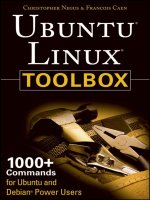Exercise2 10
Bạn đang xem bản rút gọn của tài liệu. Xem và tải ngay bản đầy đủ của tài liệu tại đây (49.51 KB, 2 trang )
Exercise 2.10
In the following problems, the data table contains bits that represent
the opcode of an instruction. You will be asked to interpret the bits as
MIPS instructions into assembly code and determine what format of
MIPS instruction the bits represent.
a.
0000 0010 0001 0000 1000 0000 0010 0000
b.
0000 0001 0100 1011 0100 1000 0010 0010
2.10.1 [5] <2.5> For the binary entries above, what instruction do
they represent?
2.10.2 [5] <2.5> What type (I-type, R-type, J-type) instruction do
the binary
entries above represent?
2.10.3 [5] <2.4, 2.5> If the binary entries above were data bits,
what number would they represent in hexadecimal?
BK
TP.HCM
04/08/2023
Faculty of Computer Science &
Engineering
1
Exercise 2.10 (cont.)
In the following problems, the data table contains MIPS
instructions. You will be asked to translate the entries into the
bits of the opcode and determine the MIPS instruction format.
BK
a.
addi $t0, $t0, 0
b.
sw $t1, 32($t2)
2.10.4 [5] <2.4, 2.5> For the instructions above, show the binary
then hexadecimal representation of these instructions.
2.10.5 [5] <2.5> What type (I-type, R-type, J-type) instruction do
the instructions above represent?
2.10.6 [5] <2.5> What is the binary then hexadecimal
representation of the opcode, Rs, and Rt fields in this instruction?
For R-type instructions, what is the hexadecimal representation of
the Rd and funct fields? For I-type instructions, what is the
hexadecimal representation of the immediate field?
TP.HCM
04/08/2023
Faculty of Computer Science &
Engineering
2

![SECTION 10: FOUNDATIONS TABLE OF CONTENTS [TO BE FURNISHED WHEN SECTION IS FINALIZED]](https://media.store123doc.com/images/document/12/pt/qq/medium_dY8TJTm9cv.jpg)







